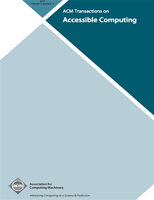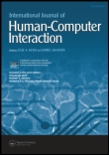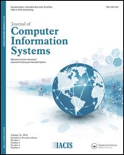
International Journal of Mobile Human Computer Interaction
Scope & Guideline
Transforming user experiences in mobile environments.
Introduction
Aims and Scopes
- User Experience Research:
The journal emphasizes research that investigates user interactions with mobile devices, including usability studies, user satisfaction, and the overall quality of user experiences. - Mobile Technology Applications:
It covers various applications of mobile technology, particularly in areas such as mental health, education, and food delivery, exploring how these technologies impact users and society. - Trust and Perception in Mobile Interfaces:
Research on user trust, likeability, and perceptions of mobile interfaces, including virtual agents and intelligent agents, is a consistent focus, highlighting factors that influence user engagement and satisfaction. - Demographic Studies in Mobile Usage:
The journal includes studies that analyze demographic factors affecting mobile technology use, such as age differences in smartphone task performance, which contribute to understanding diverse user needs. - Innovative Interaction Techniques:
Research on novel interaction techniques and design considerations for mobile interfaces, including visual aesthetics and deep learning applications, is also a key area of interest.
Trending and Emerging
- Integration of Artificial Intelligence and Machine Learning:
There is a growing trend towards exploring AI and machine learning applications in mobile interfaces, such as intelligent agents that enhance user interaction and personalize experiences. - Mental Health and Wellbeing Applications:
Research focused on mobile mental health applications is on the rise, reflecting an increasing recognition of the role of mobile technology in supporting mental health and wellbeing. - User Trust and Perception Studies:
There is an emerging emphasis on understanding user trust and perceptions related to mobile technology, particularly in the context of virtual agents and automated systems, which is crucial for user adoption. - Accessibility and Inclusivity in Mobile Design:
An increasing number of studies are addressing accessibility issues and the design of mobile applications for diverse user groups, such as visually impaired individuals, highlighting the importance of inclusive design. - Critical Incident Technique in User Experience Research:
The application of the Critical Incident Technique to explore user experiences in mobile contexts is gaining traction, allowing for deeper insights into user interactions and challenges.
Declining or Waning
- Traditional Usability Studies:
While usability remains important, traditional usability studies without innovative methodologies or technology integration seem to be less frequent, possibly due to the increasing complexity of mobile applications. - General Demographic Analysis:
Broad demographic analyses without specific insights or actionable outcomes for mobile technology usage are appearing less often, indicating a move towards more targeted studies that provide deeper insights. - Static Comparisons of Mobile Interfaces:
Comparative studies of mobile interfaces that do not incorporate evolving technologies or user-centric approaches are waning, as the field shifts towards more dynamic and user-focused research.
Similar Journals

ACM Transactions on Accessible Computing
Bridging the gap in accessible technology.ACM Transactions on Accessible Computing, with ISSN 1936-7228 and E-ISSN 1936-7236, is a prestigious journal published by the Association for Computing Machinery. Established to advance the field of accessible computing, this journal plays a critical role in promoting research that enhances the usability of computer technology for individuals with diverse accessibility needs. Its impact is reflected in its 2023 Scopus rankings, placing it in the Q2 category for Computer Science Applications and Q3 for Human-Computer Interaction, making it a significant resource for researchers and practitioners alike. With an ongoing publication timeline from 2008 through 2024, the journal not only contributes to theoretical advancements but also addresses practical implications in the realm of inclusive design and innovation. Although not Open Access, the journal is a vital forum for disseminating cutting-edge research, ensuring that advancements in technology are accessible to all.

INTERNATIONAL JOURNAL OF HUMAN-COMPUTER INTERACTION
Exploring the Synergy Between Humans and TechnologyINTERNATIONAL JOURNAL OF HUMAN-COMPUTER INTERACTION, published by Taylor & Francis Inc, stands at the forefront of research within the interdisciplinary fields of human-computer interaction, human factors, and ergonomics. Since its establishment, the journal has consistently contributed to advancing the understanding of the interactions between people and computers, making it a vital resource for researchers, professionals, and students alike. With an impressive impact factor reflecting its high citation rate, this journal is recognized as a Q1 publication in both Computer Science Applications and Human Factors and Ergonomics categories for 2023, showcasing its stature within the academic community. Additionally, it boasts a commendable ranking within the top percentiles in key areas on Scopus, ensuring that the research published here reaches broad scholarly audiences. Available in traditional subscription format, the journal covers seminal studies from 1989 to 2024, reflecting ongoing innovation in technology and its applications in everyday life, and thus serves as an essential platform for pioneering research that shapes the future of user experience.

International Journal of Affective Engineering
Exploring the intersection of emotion and technology.Welcome to the International Journal of Affective Engineering, an esteemed publication dedicated to advancing the interdisciplinary fields of affective engineering and human-centered design. Published by the Japan Society of Kansei Engineering, this journal aims to foster innovative research that bridges emotional perception with engineering practices, ultimately enhancing user experiences across various applications. As a peer-reviewed platform, the journal plays a pivotal role in disseminating groundbreaking studies and methodologies, positioning itself as a valuable resource within the academic landscape. The journal is designed for a diverse audience, including researchers, industry professionals, and students committed to exploring the emotional dimensions of technology. Although it currently operates under a subscription model, the journal remains open to new research contributions that emphasize the significance of affective design in technology development. With its focus on quality research, the International Journal of Affective Engineering is poised to make a substantial impact in the evolving field of affective sciences.

JOURNAL OF COMPUTER INFORMATION SYSTEMS
Connecting Research and Innovation in TechnologyThe JOURNAL OF COMPUTER INFORMATION SYSTEMS, published by Taylor & Francis Inc, is a prestigious academic journal dedicated to the fields of computer science and information systems. With an ISSN of 0887-4417 and an E-ISSN of 2380-2057, this journal has been a valuable resource since its inception in 1995, contributing to the convergence of research until 2024. The journal holds significant status in its respective categories, achieving a Q2 ranking in Computer Networks and Communications, and a Q1 ranking in Education, demonstrating its impact and relevance to a broad academic audience. With Scopus rankings placing it in the 90th percentile for Social Sciences - Education and respectable standings in Computer Science, it serves as a critical forum for the dissemination of innovative research, methodologies, and case studies within the domains of computer information systems. Although not an open-access journal, it remains a highly cited source, attracting researchers, educators, and professionals seeking to enhance their knowledge and contribute to the evolving discourse in technology and education.

Journal of Information and Communication Technology-Malaysia
Driving Technological Advancement Through Open AccessJournal of Information and Communication Technology-Malaysia is a respected open-access journal published by UNIV UTARA MALAYSIA PRESS, dedicated to advancing knowledge in the fields of Information Technology, Computer Science, and Mathematics. With an ISSN of 1675-414X and an E-ISSN of 2180-3862, this journal has been providing a platform for innovative research since its establishment in 2009. The journal is indexed in Scopus with commendable rankings in Mathematics and Computer Science categories, highlighting its contribution to the academic community, particularly with its Q3 quartile status in both fields as of 2023. As it converges research from 2011 to 2024, the journal invites submissions that explore contemporary challenges and technological advancements, catering to a global audience of researchers, professionals, and students interested in the rapidly evolving domains of ICT. By ensuring open access to its articles, the journal promotes widespread dissemination and accessibility of cutting-edge research, thereby supporting the collaborative development of ideas and solutions in these critical areas.

MOBILE NETWORKS & APPLICATIONS
Exploring the Future of Mobile ConnectivityMOBILE NETWORKS & APPLICATIONS, published by Springer, is a leading journal in the fields of Computer Networks and Communications, Hardware and Architecture, Information Systems, and Software. With an impact factor that underscores its significance in the realm of mobile computing, this journal serves as a critical platform for disseminating cutting-edge research and innovative applications from both theoretical and practical perspectives. Established in 1996 and continuing until 2024, it has consistently ranked within the Q2 quartile across various computer science categories, highlighting its commitment to excellence and rigorous peer review. The journal's reach extends globally, providing valuable insights to researchers, professionals, and students alike. Notably, it occupies impressive ranks in Scopus, including 51st in Computer Networks and Communications and 26th in Hardware and Architecture, illustrating its high standing in the academic community. Engaging with this journal means accessing a wealth of knowledge that drives forward the rapidly evolving landscape of mobile networks and applications.

IADIS-International Journal on Computer Science and Information Systems
Connecting Ideas, Inspiring Research in Computer ScienceIADIS-International Journal on Computer Science and Information Systems is a prominent platform dedicated to advancing research and knowledge in the field of computer science and information systems. Published by IADIS, this journal aims to disseminate innovative findings and theoretical advancements that address contemporary challenges and trends in technology. The journal fosters a rigorous peer-review process, ensuring that only high-quality research is shared with its audience, which includes researchers, professionals, and students from around the globe. Although the journal is not currently open access, it serves as a vital resource for those looking to deepen their understanding of the evolving landscape of computer science. The ISSN of this journal is 1646-3692, and it boasts a strong commitment to promoting interdisciplinary communication and collaboration in the realm of information technology, making it an essential read for anyone looking to stay at the forefront of this fast-paced field.

Proceedings of the ACM on Interactive Mobile Wearable and Ubiquitous Technologies-IMWUT
Unveiling Breakthroughs in Interactive Wearable TechProceedings of the ACM on Interactive Mobile Wearable and Ubiquitous Technologies (IMWUT) is a premier journal published by the Association for Computing Machinery (ACM), dedicated to the rapidly evolving fields of interactive mobile technologies, wearable devices, and ubiquitous computing. Since its inception in 2017, IMWUT has established itself as a vital resource for researchers and practitioners, earning a prestigious Q1 ranking across multiple categories, including Computer Networks and Communications, Hardware and Architecture, and Human-Computer Interaction, as evidenced by its impressive Scopus metrics. With its open-access model and a focus on cutting-edge research, IMWUT aims to disseminate innovative solutions and technological advancements that enhance user experiences across diverse environments. Researchers, industry professionals, and students are encouraged to explore this journal to stay at the forefront of research and developments in interactive technologies.

GetMobile-Mobile Computing & Communications Review
Unveiling Trends in Mobile CommunicationsGetMobile-Mobile Computing & Communications Review, published by the Association for Computing Machinery (ACM), is a leading journal dedicated to the evolving field of mobile computing and communication technologies. With an ISSN of 2375-0529 and an E-ISSN of 2375-0537, this publication serves as a vital resource for researchers, professionals, and students, providing insights into the latest advancements, trends, and challenges in mobile technology. The journal covers a comprehensive range of topics, including but not limited to mobile networks, communications protocols, mobile applications, and edge computing, making it invaluable for those in academia and industry alike. Although specific metrics such as impact factor and H-index are currently unavailable, GetMobile is recognized for fostering innovative research and promoting knowledge exchange in mobile and computational communications. As the field continues to grow, this journal remains pivotal for disseminating impactful studies and practical applications that drive the future of mobile technology.

Multimodal Technologies and Interaction
Connecting Disciplines for Cutting-Edge Interaction.Multimodal Technologies and Interaction, published by MDPI since 2017, is an esteemed open-access journal based in Switzerland, dedicated to the exploration and advancement of innovative multimodal systems that enhance user experience across various digital platforms. With its commitment to disseminating high-quality research in diverse areas such as Computer Networks and Communications, Human-Computer Interaction, and Neuroscience, the journal has rapidly established itself within the academic community, achieving a commendable position in Scopus rankings including Q2 in both Computer Networks and Communications and Computer Science Applications. As an essential resource for researchers, professionals, and students alike, Multimodal Technologies and Interaction fosters interdisciplinary dialogue and supports the development of cutting-edge technologies, ensuring that advancements in multimodal interaction are accessible to a global audience. Scholars can benefit from its Open Access format, allowing unrestricted access to influential studies that shape the future of technology and interaction design.